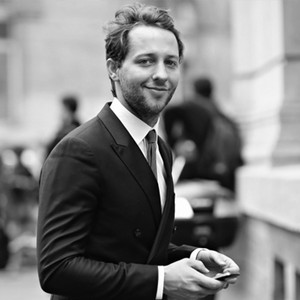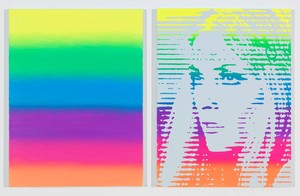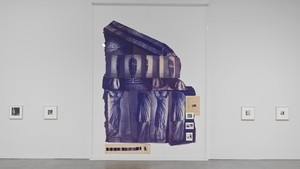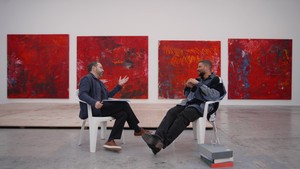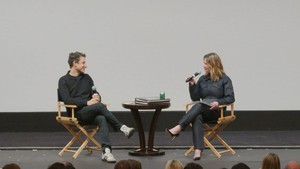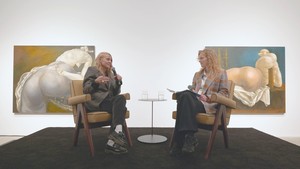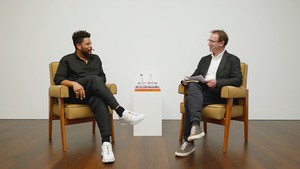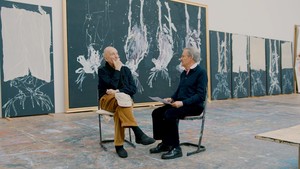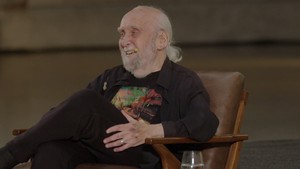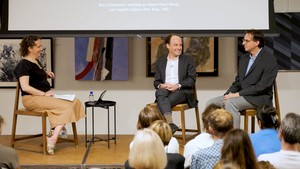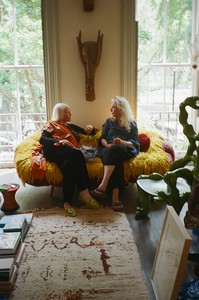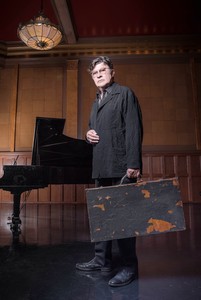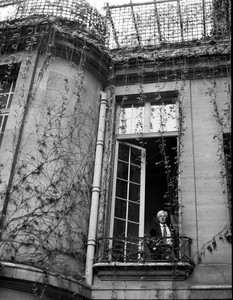Derek BlasbergYour new show of paintings opened on June 11 at Gagosian Athens. What are we seeing in the Athens show?
Richard PhillipsIt’s a group of paintings that I have worked on for the past year. They represent an evolution away from the ultra-real paintings and a turn toward graphic images. By that I mean less dimensional reality and more two dimensional, and a more luminous quality. The paintings are smaller too, they’re portrait-sized paintings.
DBWhy do you think you’ve veered more toward this work?
RPThe graphic quality of the imagery combined with the physical emphasis of the painting process opens up a different way to experience content. It effects the senses in a way that is less focused on the assessment of mimetic description and more on how color and surface generate an emotional response.
DBAnd technically speaking, how did you achieve this?
RPI used a lot of fluorescent pigment and wax emulsion. It’s a very traditional medium, it gives a smooth and beautiful surface. It relies more on the palette knife, as opposed to brushstrokes. They appear thickly painted even though they’re flat.
DBLet’s speak about the subjects, which I know has been a big part of your work in the past. Who are the subjects of these works?
RPThe subjects represent a shift in perspective to a radicalized counterculture avant-garde, moving away from photo-based documentation or propaganda media to graphic coefficients of this imagery. In this exhibition, the two recognizable subjects are Jim Morrison and Sharon Tate. Both are icons of ’60s pop and counterculture, but for different reasons. Jim is a cult figure of divine proportion who channeled a collective response to forces beyond control, and Sharon who simultaneously became an icon and a martyr to both positive and negative poles of the very same forces.
DBI know that “zine” culture and psychedelic posters from the 1960s were an influence on this show. Why?
RPI may be dating myself when I say this, but that’s the time I grew up in. It’s mainly the counterculture that interested me, both in music and in graphic presentation of it, too. A really important part of this came from my friend John McWhinnie, who put aside a group of magazines for me from the Process Church, which was one of the zines that was used as evidence in the Charles Manson case.
DBFor you, is there a line between movie stars and politicians, or is celebrity a celebrity?
RPThere is a distinct difference in how illusion is used that effects realities. The movie star uses media to create an illusion to point toward a fictitious reality that has a bearing on one’s life, in expanding one’s fantastic relationships to ideas, which are far beyond that which will effect one’s personal life. The politician uses media to create an illusion of reality that points away from and obscures policies that, by contrast, have a direct impact on one’s life.
DBWho was the first “famous” subject that you were inspired by?
RPMy first “famous subject” that I painted in 1995/96 for my first solo show was actually Sharon Tate. Her fame embraces the complexity of the 1960s idealism and the undercurrent of violence and extremism, which was a cohabitant of this revolutionary mindset. Her position as an actor, model, and icon of celebrity culture amplified the tragedy of the loss collectively felt by her senseless murder at the hands of Manson’s followers.
DBI read somewhere that you like dlisted.com, which is about the only website I read regularly.
RPI visit that site less frequently, but dlisted is an excellent portal into an unvarnished view of celebrity critique that accepts the necessary paring of the production of purposeless media and societal degradation as entertainment.
DBYou once mentioned that the art world has a red carpet and that you’re inspired by that.
RPIn 2009 and 2010, I created two exhibitions, New Museum and Most Wanted, that took on the relationships of the art world’s institutions and their need for celebrity endorsement and luxury goods based sponsorship. The abstraction that was being created was that there was somehow a division between the art produced and the necessary financing and verification. My exhibitions served to establish the reality that the art was located precisely in this necessary constellation. While my new exhibition accepts this fact, it is free to address the ideologies at work beyond the diagnostics of pure production and sustainability of culture, and enters into a sensory-based realm of irrationality, emotional resonance, and psychological unpredictability, or to use a ’60s lyric “the other side of this life.”

